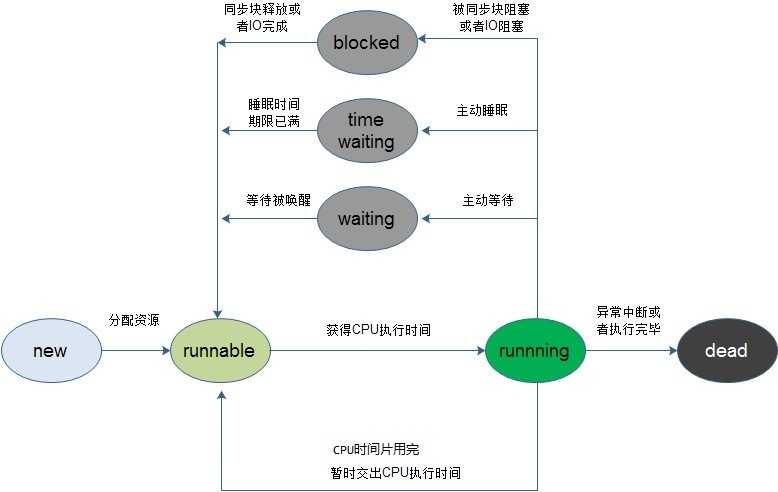标签:
线程的状态
线程从创建到最终的消亡,要经历若干个状态。一般来说,线程包括以下这几个状态:创建(new)、就绪(runnable)、运行(running)、阻塞(blocked)、time waiting、waiting、消亡(dead)。
当需要新起一个线程来执行某个子任务时,就创建了一个线程。但是线程创建之后,不会立即进入就绪状态,因为线程的运行需要一些条件(比如内存资源,在前面的JVM内存区域划分一篇博文中知道程序计数器、Java栈、本地方法栈都是线程私有的,所以需要为线程分配一定的内存空间),只有线程运行需要的所有条件满足了,才进入就绪状态。线程进入就绪状态后,不代表立刻就能获取CPU执行时间,也许此时CPU正在执行其他的事情,因此它要等待。当得到CPU执行时间之后,线程便真正进入运行状态。
线程在运行状态过程中,可能有多个原因导致当前线程不继续运行下去,比如用户主动让线程睡眠(睡眠一定的时间之后再重新执行)、用户主动让线程等待,或者被同步块给阻塞,此时就对应着多个状态:time waiting(睡眠或等待一定的事件)、waiting(等待被唤醒)、blocked(阻塞)。
当由于突然中断或者子任务执行完毕,线程就会被消亡。

Thread类
public
class Thread implements Runnable {
/* Make sure registerNatives is the first thing <clinit> does. */
private static native void registerNatives();
static {
registerNatives();
}
private volatile char name[];
private int priority;
private Thread threadQ;
private long eetop;
/* Whether or not to single_step this thread. */
private boolean single_step;
/* Whether or not the thread is a daemon thread. */
private boolean daemon = false;
/* JVM state */
private boolean stillborn = false;
/* What will be run. */
private Runnable target;
/* The group of this thread */
private ThreadGroup group;
/* The context ClassLoader for this thread */
private ClassLoader contextClassLoader;
/* The inherited AccessControlContext of this thread */
private AccessControlContext inheritedAccessControlContext;
/* For autonumbering anonymous threads. */
private static int threadInitNumber;
private static synchronized int nextThreadNum() {
return threadInitNumber++;
}
/* ThreadLocal values pertaining to this thread. This map is maintained
* by the ThreadLocal class. */
ThreadLocal.ThreadLocalMap threadLocals = null;
/*
* InheritableThreadLocal values pertaining to this thread. This map is
* maintained by the InheritableThreadLocal class.
*/
ThreadLocal.ThreadLocalMap inheritableThreadLocals = null;
Thread类实现了Runnable接口,在Thread类中,有一些比较关键的属性,比如name是表示Thread的名字,可以通过Thread类的构造器中的参数来指定线程名字,priority表示线程的优先级(最大值为10,最小值为1,默认值为5),daemon表示线程是否是守护线程,target表示要执行的任务。
以下是关系到线程运行状态的几个方法:
1)start方法
start()用来启动一个线程,当调用start方法后,系统才会开启一个新的线程来执行用户定义的子任务,在这个过程中,会为相应的线程分配需要的资源。
2)run方法
run()方法是不需要用户来调用的,当通过start方法启动一个线程之后,当线程获得了CPU执行时间,便进入run方法体去执行具体的任务。注意,继承Thread类必须重写run方法,在run方法中定义具体要执行的任务。
3)sleep方法
sleep方法有两个重载版本:
sleep(long millis) //参数为毫秒 sleep(long millis,int nanoseconds) //第一参数为毫秒,第二个参数为纳秒
如果调用了sleep方法,必须捕获InterruptedException异常或者将该异常向上层抛出。当线程睡眠时间满后,不一定会立即得到执行,因为此时可能CPU正在执行其他的任务。所以说调用sleep方法相当于让线程进入阻塞状态。
4)yield方法.yield跟sleep()一样可以直接用Thread类调用,调用yield方法会让当前线程交出CPU权限,让CPU去执行其他的线程。它跟sleep方法类似,同样不会释放锁。但是yield不能控制具体的交出CPU的时间,另外,yield方法只能让拥有相同优先级的线程有获取CPU执行时间的机会。如果没有相同级别的线程在等待CPU的执行权,则该线程继续执行。
5)join方法用线程对象调用,如果在一个线程A中调用另一个线程B的join方法,线程A将会等待线程B执行完毕后再执行。
join() join(long millis) //参数为毫秒 join(long millis,int nanoseconds) //第一参数为毫秒,第二个参数为纳秒如在main线程中,调用thread.join方法,则main方法会等待thread线程执行完毕或者等待一定的时间。如果调用的是无参join方法,则等待thread执行完毕,如果调用的是指定了时间参数的join方法,则等待一定的时间。
public class Test {
public static void main(String[] args) throws IOException {
System.out.println("进入线程"+Thread.currentThread().getName());
Test test = new Test();
MyThread thread1 = test.new MyThread();
thread1.start();
try {
System.out.println("线程"+Thread.currentThread().getName()+"等待");
thread1.join();
System.out.println("线程"+Thread.currentThread().getName()+"继续执行");
} catch (InterruptedException e) {
// TODO Auto-generated catch block
e.printStackTrace();
}
}
class MyThread extends Thread{
@Override
public void run() {
System.out.println("进入线程"+Thread.currentThread().getName());
try {
Thread.currentThread().sleep(5000);
} catch (InterruptedException e) {
// TODO: handle exception
}
System.out.println("线程"+Thread.currentThread().getName()+"执行完毕");
}
}
}结果:
进入线程main
线程main等待
进入线程Thread-0
线程Thread-0执行完毕
线程main继续执行
可以看出,当调用thread1.join()方法后,main线程会进入等待,然后等待thread1执行完之后再继续执行。
实际上调用join方法是调用了Object的wait方法(查看源码)
wait方法会让线程进入阻塞状态,并且会释放线程占有的锁,并交出CPU执行权限。
由于wait方法会让线程释放对象锁,所以join方法同样会让线程释放对一个对象持有的锁。具体的wait方法使用在后面文章中给出。
6)interrupt方法
interrupt,顾名思义,即中断的意思。单独调用interrupt方法可以使得处于阻塞状态的线程抛出一个异常,也就说,它可以用来中断一个正处于阻塞状态的线程;另外,通过interrupt方法和isInterrupted()方法来停止正在运行的线程。
public class Test {
public static void main(String[] args) throws IOException {
Test test = new Test();
MyThread thread = test.new MyThread();
thread.start();
try {
Thread.currentThread().sleep(2000);
} catch (InterruptedException e) {
}
thread.interrupt();
}
class MyThread extends Thread{
@Override
public void run() {
try {
System.out.println("进入睡眠状态");
Thread.currentThread().sleep(10000);
System.out.println("睡眠完毕");
} catch (InterruptedException e) {
System.out.println("得到中断异常");
}
System.out.println("run方法执行完毕");
}
}
}结果:
进入睡眠状态
得到中断
run方法执行完毕
从这里可以看出,通过interrupt方法可以中断处于阻塞状态的线程。那么能不能中断处于非阻塞状态的线程呢?看下面这个例子:
public class Test {
public static void main(String[] args) throws IOException {
Test test = new Test();
MyThread thread = test.new MyThread();
thread.start();
try {
Thread.currentThread().sleep(2000);
} catch (InterruptedException e) {
}
thread.interrupt();
}
class MyThread extends Thread{
@Override
public void run() {
int i = 0;
while(i<Integer.MAX_VALUE){
System.out.println(i+" while循环");
i++;
}
}
}
}运行该程序会发现,while循环会一直运行直到变量i的值超出Integer.MAX_VALUE。所以说直接调用interrupt方法不能中断正在运行中的线程。public class Test {
public static void main(String[] args) throws IOException {
Test test = new Test();
MyThread thread = test.new MyThread();
thread.start();
try {
Thread.currentThread().sleep(2000);
} catch (InterruptedException e) {
}
thread.interrupt();
}
class MyThread extends Thread{
@Override
public void run() {
int i = 0;
while(!isInterrupted() && i<Integer.MAX_VALUE){
System.out.println(i+" while循环");
i++;
}
}
}
}
class MyThread extends Thread{
private volatile boolean isStop = false;
@Override
public void run() {
int i = 0;
while(!isStop){
i++;
}
}
public void setStop(boolean stop){
this.isStop = stop;
}
} 4)setDaemon和isDaemon用来设置线程是否成为守护线程和判断线程是否是守护线程。
守护线程和用户线程的区别在于:守护线程依赖于创建它的线程,而用户线程则不依赖。举个简单的例子:如果在main线程中创建了一个守护线程,当main方法运行完毕之后,守护线程也会随着消亡。而用户线程则不会,用户线程会一直运行直到其运行完毕。在JVM中,像垃圾收集器线程就是守护线程。
Thread类有一个比较常用的静态方法currentThread()用来获取当前线程。
标签:
原文地址:http://blog.csdn.net/gongpulin/article/details/51227489